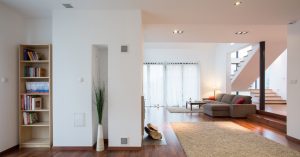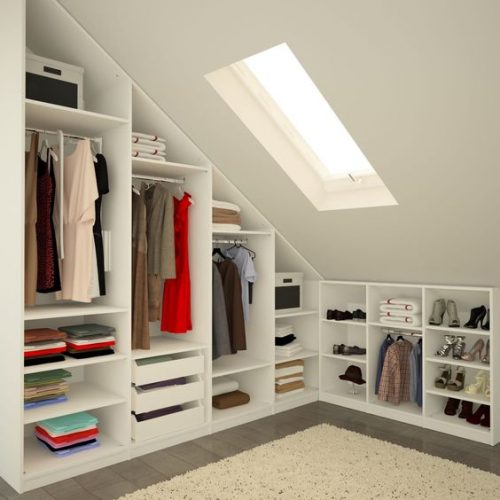The Versatility of Space in Design

If we don’t have versatility in our home, that means we’re not making the most out of each object and the space that we have.
Space and the way we distribute it is one of the hardest things to think about when we’re designing a space. That’s why having coherence between design and function is one of the most important issues when considering an architectural solution for our environment.
In most cases, the problem isn’t the actual dimensions of the space. It lies in the creativity and ingenuity that you have to make any space as functional and attractive as possible.
Versatility is a fundamental aspect in our homes. We should’t forget to consider how versatile a space is – if we do, we won’t get the most out of our homes. When we correctly arrange a space we give it the ability to adapt to changing needs. A versatile space allows for functionality and practicality.
Each space has a different character depending on the style we’re aiming to achieve. Our personal design allows us to give a space a more serious touch, or a more casual one.
The furniture and accessories that live in a room play an important role as well. They allow us to separate our environments and provide functionality.
But what happens when we have a small space? In this case, the most important thing is to maximize our space to its fullest potential. If we’re able to do this as well as give it a well-designed touch, we’re going to be happy.
In today’s post, we’ll give you some guidelines on how to achieve the maximum use of your space while also finding the most appropriate style.
How to correctly arrange furniture
You’ve probably asked yourself before if you’re really getting the most out of your space and if you’ve placed your furniture to be as functional as possible. We’ll give you some tricks on how to arrange your furniture in an ideal way in this section.
There are many things on the market that allow you to separate environments or areas, but the most common are sofas and shelves.
The sofas create what we call a “conversation area”. You can group of furniture around a coffee table. Think about incorporating armchairs, a carpet, and a sofa. Don’t place them too far apart. That will give a feeling of emptiness. You also don’t want to bunch them too closely together. The room will feel crowded if you do this. You shouldn’t overwhelm the space – you’re just looking to achieve a sense of balance.

Shelf-wall / micasrevista.com
Shelves can serve as “fake walls” and also be a place to store your things. If you play with the height of the shelves, you can create a space between the kitchen and the dining area, for example.
Versatility in decor: versatile styles
Next, we will briefly explain several decor styles that are known for their versatility and practicality.
Industrial style
This style originates in the architecture belonging to New York City and its 1950’s industry. With the industrial style, the main visual components include using old brick and metallic materials. In addition, exposed steel and wooden elements are popular. It’s usually cold, rustic, and a little rough around the edges. This style is ideal to give a sense of depth because it uses the perfect materials for the job.
Scandinavian style
This style comes from the colder countries in northern Europe, such as Norway, Denmark, and Sweden. These countries are known for using their craftsmanship and industrial skills in their designs. They use a lot of natural materials like wood or marble, and they combine them with light colors and straight lines. Its basic foundation is simplicity, comfort, and above all, functionality. This style is perfect to gain space because it uses natural elements that give depth to your home.

Scandinavian style closet / homify.com
Ethnic style
The main idea of this style is the use of robust and strong furniture, with straight lines. It’s very similar to the Scandinavian style, with the difference that it’s a little more Bohemian. In addition, it focuses a lot more on using accessories and different elements from various cultures. With this style you’ll achieve a touch of personality in your home to create a unique space.
Rustic style
The rustic style attempts to take a home in the suburbs or the city and give it a woody or outdoorsy feel. If your home is rustic, you can give it a rural-chic look.
Wood plays a very important role in this style since everything is related to nature and the countryside. You’ll want as many natural elements in your home as possible. Having plants is also important because they give a touch of green and freshness to the environment. A rustic style home is very casual, comfortable, and cozy.

Rustic wood style / delikatissen.com
In conclusion, all these styles use materials in a minimal way and give a feeling of spaciousness. It’s important to discover which style best fits your personalty, and that will allow you to get the most out of your home. Therefore, if what you’re looking for is to give a functional and versatile touch to your home, any of these is perfect for you.
If we don’t have versatility in our home, that means we’re not making the most out of each object and the space that we have.
Space and the way we distribute it is one of the hardest things to think about when we’re designing a space. That’s why having coherence between design and function is one of the most important issues when considering an architectural solution for our environment.
In most cases, the problem isn’t the actual dimensions of the space. It lies in the creativity and ingenuity that you have to make any space as functional and attractive as possible.
Versatility is a fundamental aspect in our homes. We should’t forget to consider how versatile a space is – if we do, we won’t get the most out of our homes. When we correctly arrange a space we give it the ability to adapt to changing needs. A versatile space allows for functionality and practicality.
Each space has a different character depending on the style we’re aiming to achieve. Our personal design allows us to give a space a more serious touch, or a more casual one.
The furniture and accessories that live in a room play an important role as well. They allow us to separate our environments and provide functionality.
But what happens when we have a small space? In this case, the most important thing is to maximize our space to its fullest potential. If we’re able to do this as well as give it a well-designed touch, we’re going to be happy.
In today’s post, we’ll give you some guidelines on how to achieve the maximum use of your space while also finding the most appropriate style.
How to correctly arrange furniture
You’ve probably asked yourself before if you’re really getting the most out of your space and if you’ve placed your furniture to be as functional as possible. We’ll give you some tricks on how to arrange your furniture in an ideal way in this section.
There are many things on the market that allow you to separate environments or areas, but the most common are sofas and shelves.
The sofas create what we call a “conversation area”. You can group of furniture around a coffee table. Think about incorporating armchairs, a carpet, and a sofa. Don’t place them too far apart. That will give a feeling of emptiness. You also don’t want to bunch them too closely together. The room will feel crowded if you do this. You shouldn’t overwhelm the space – you’re just looking to achieve a sense of balance.

Shelf-wall / micasrevista.com
Shelves can serve as “fake walls” and also be a place to store your things. If you play with the height of the shelves, you can create a space between the kitchen and the dining area, for example.
Versatility in decor: versatile styles
Next, we will briefly explain several decor styles that are known for their versatility and practicality.
Industrial style
This style originates in the architecture belonging to New York City and its 1950’s industry. With the industrial style, the main visual components include using old brick and metallic materials. In addition, exposed steel and wooden elements are popular. It’s usually cold, rustic, and a little rough around the edges. This style is ideal to give a sense of depth because it uses the perfect materials for the job.
Scandinavian style
This style comes from the colder countries in northern Europe, such as Norway, Denmark, and Sweden. These countries are known for using their craftsmanship and industrial skills in their designs. They use a lot of natural materials like wood or marble, and they combine them with light colors and straight lines. Its basic foundation is simplicity, comfort, and above all, functionality. This style is perfect to gain space because it uses natural elements that give depth to your home.

Scandinavian style closet / homify.com
Ethnic style
The main idea of this style is the use of robust and strong furniture, with straight lines. It’s very similar to the Scandinavian style, with the difference that it’s a little more Bohemian. In addition, it focuses a lot more on using accessories and different elements from various cultures. With this style you’ll achieve a touch of personality in your home to create a unique space.
Rustic style
The rustic style attempts to take a home in the suburbs or the city and give it a woody or outdoorsy feel. If your home is rustic, you can give it a rural-chic look.
Wood plays a very important role in this style since everything is related to nature and the countryside. You’ll want as many natural elements in your home as possible. Having plants is also important because they give a touch of green and freshness to the environment. A rustic style home is very casual, comfortable, and cozy.

Rustic wood style / delikatissen.com
In conclusion, all these styles use materials in a minimal way and give a feeling of spaciousness. It’s important to discover which style best fits your personalty, and that will allow you to get the most out of your home. Therefore, if what you’re looking for is to give a functional and versatile touch to your home, any of these is perfect for you.







